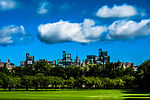George Heriot's School
1628 establishments in ScotlandBuildings and structures completed in 1628Category A listed buildings in EdinburghEducational institutions established in the 1650sIndependent schools in Edinburgh ... and 7 more
Member schools of the Headmasters' and Headmistresses' ConferenceOld Town, EdinburghRenaissance architecture in ScotlandSchool buildings completed in the 17th centuryUse British English from March 2017William Bruce buildingsWilliam Wallace buildings

George Heriot's School is a Scottish independent primary and secondary day school on Lauriston Place in the Old Town of Edinburgh, Scotland. In the early 21st century, it has more than 1600 pupils, 155 teaching staff, and 80 non-teaching staff. It was established in 1628 as George Heriot's Hospital, by bequest of the royal goldsmith George Heriot, and opened in 1659. It is governed by George Heriot's Trust, a Scottish charity.
Excerpt from the Wikipedia article George Heriot's School (License: CC BY-SA 3.0, Authors, Images).George Heriot's School
Lauriston Place, City of Edinburgh Tollcross
Geographical coordinates (GPS) Address Website External links Nearby Places Show on map
Geographical coordinates (GPS)
| Latitude | Longitude |
|---|---|
| N 55.945918 ° | E -3.194317 ° |
Address
George Heriot's School
Lauriston Place
EH3 9EQ City of Edinburgh, Tollcross
Scotland, United Kingdom
Open on Google Maps










